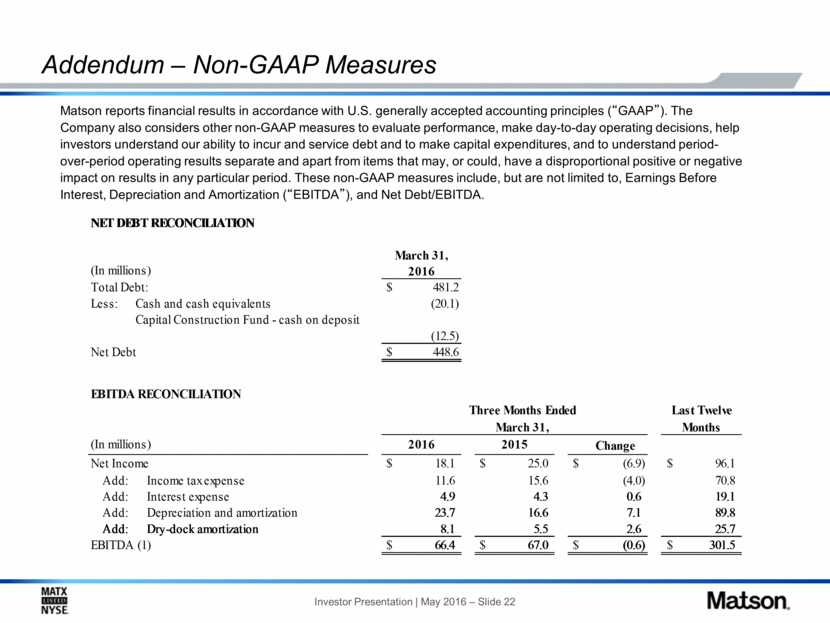Attached files
| file | filename |
|---|---|
| 8-K - 8-K - Matson, Inc. | a16-10859_18k.htm |
Exhibit 99.1
Investor Presentation – May 2016
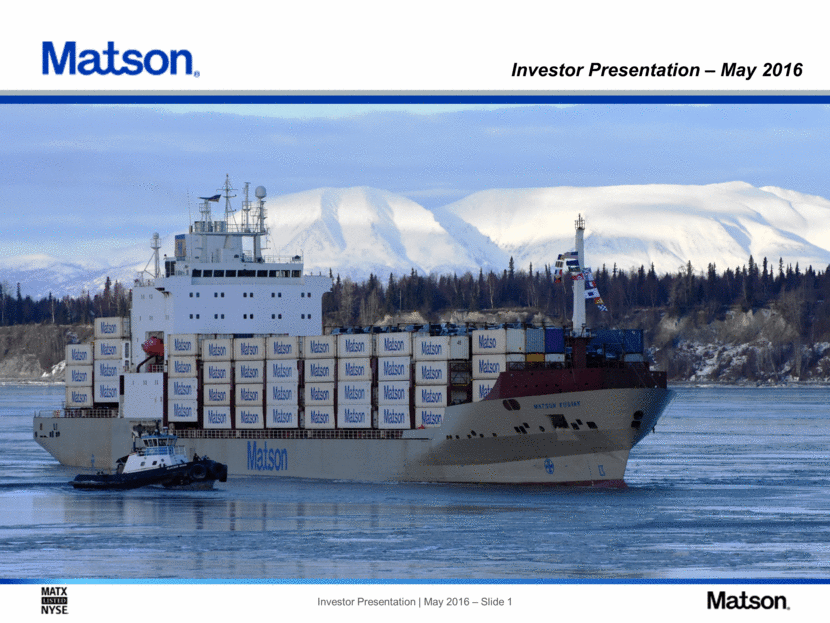
Forward Looking Statements Statements made during this presentation that set forth expectations, predictions, projections or are about future events are based on facts and situations that are known to us as of May 10, 2016. We believe that our expectations and assumptions are reasonable. Actual results may differ materially, due to risks and uncertainties, such as those described on pages 8-15 of the 2015 Form 10-K filed on February 26, 2016, and other subsequent filings by Matson with the SEC. Statements made during this presentation are not guarantees of future performance. We do not undertake any obligation to update our forward-looking statements.

Matson Today: Connecting the Pacific Alaska SEA/OAK/HI OAK/HI and LB/HI China-Long Beach Express Hawaiian Islands Guam/Micronesia South Pacific
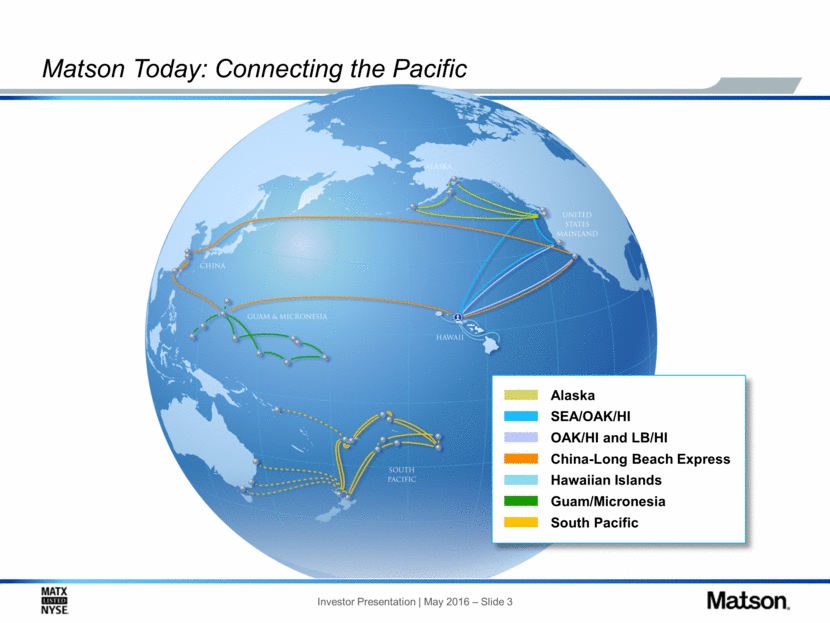
Investment Highlights Leveraging the Matson brand and network into growth opportunities Well maintained fleet with leading on-time vessel arrivals Fastest transit and cargo availability creates 4 to 10 day advantage and premium rates for China service Dedicated terminals with best in class truck turns Varied and ample equipment fleet across locations to meet customer needs World class operator and premium service provider Leading U.S. carrier in the Pacific providing lifeline to economies of Hawaii, Alaska and Guam Leading market share in attractive niche markets with multi-decade customer relationships Dual head-haul economics on China service Unique network connecting the Pacific Financial strength to invest in fleet renewal and equipment, pursue strategic opportunities and return capital to shareholders Significant cash flow generation Investment grade credit metrics Strong balance sheet
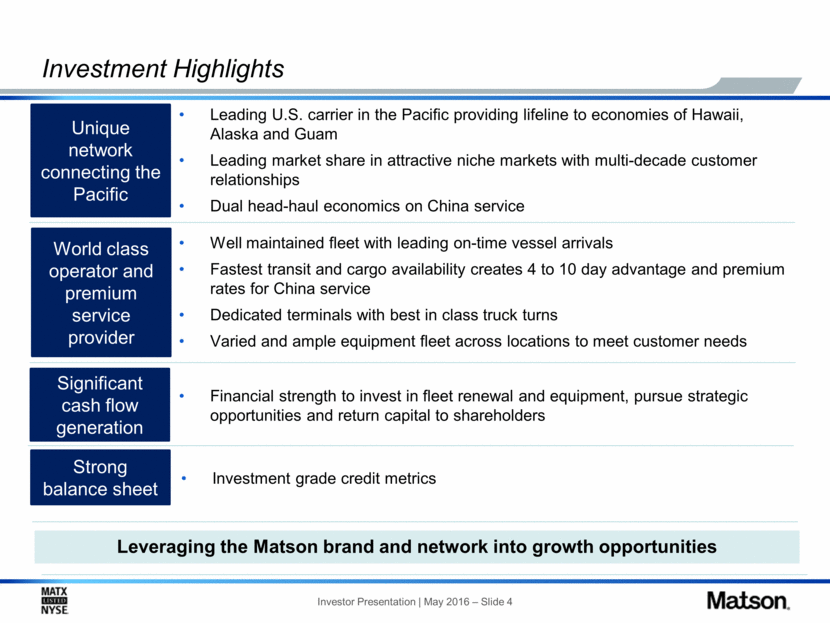
Matson is the leading carrier into Oahu and Neighbor Islands, providing “just-in-time” supply lifeline 5 weekly USWC departures 4 weekly Honolulu arrivals 11-ship fleet deployment offering most frequent and reliable service Matson deploys ~70% of weekly containership capacity to Honolulu Only containership service from Pacific Northwest and only direct containership service from Oakland Competitor deployment changes in June 2015 Withdrew from Pacific Northwest No longer offers Oakland direct service Added second call in LA/Long Beach Market and Service Leader to Hawaii Competitor’s 5-Ship Deployment
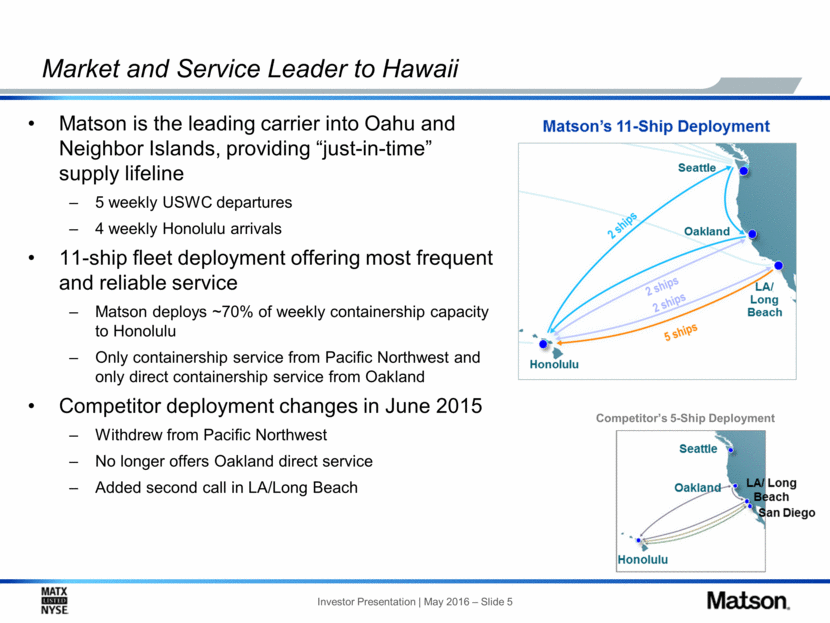
Construction in progress on Matson’s two 3,600 TEU “Aloha Class” vessels at Philly Shipyard Expected delivery dates: 3Q18 and 1Q19 Expected benefits of Aloha Class vessels Significantly lowers cost per container in Hawaii fleet Carry higher freight volumes with fewer vessels deployed Expect 10-ship deployment upon delivery of two Aloha Class vessels Lower crewing, maintenance & repair, and dry-docking costs Approximately 30% lower fuel consumption per TEU using conventional fuel oils Continuing to evaluate ordering two additional new vessels to complete renewal of Hawaii fleet Expect 9-ship deployment upon delivery of two additional new vessels In Hawaii Would avoid additional capital investment in end of life vessels Hawaii Fleet Update First steel cut for Aloha Class vessels
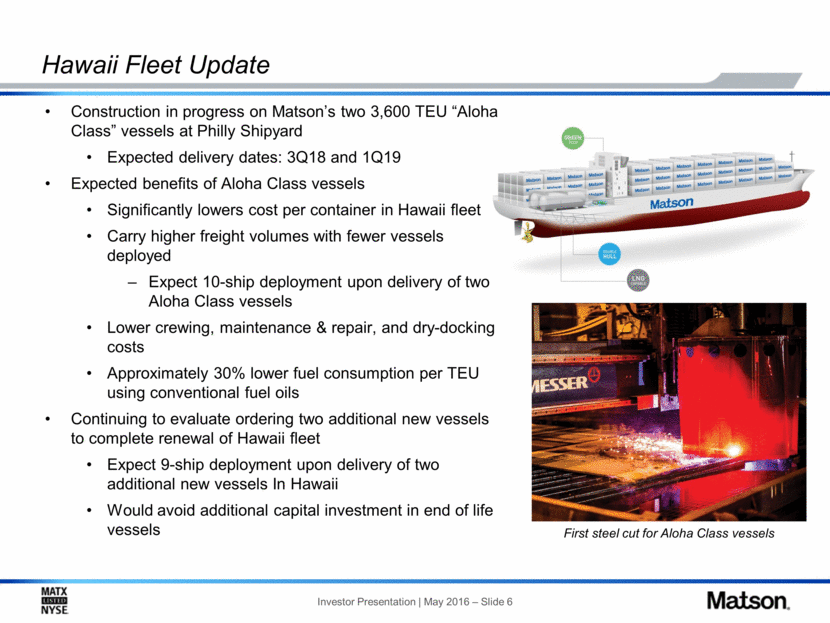
Utilization of Jones Act ships in round trip dual head-haul revenue model Weekly 5 ship string connecting 3 ports in China to LA / Long Beach Matson’s expedited service results in 4 to 10 day competitive advantage and premium rates During USWC labor disruption service advantage was as much as 3 weeks Attracts high value, time sensitive cargo Unique Expedited China Service (CLX) Shanghai Ningbo Xiamen LA/ Long Beach
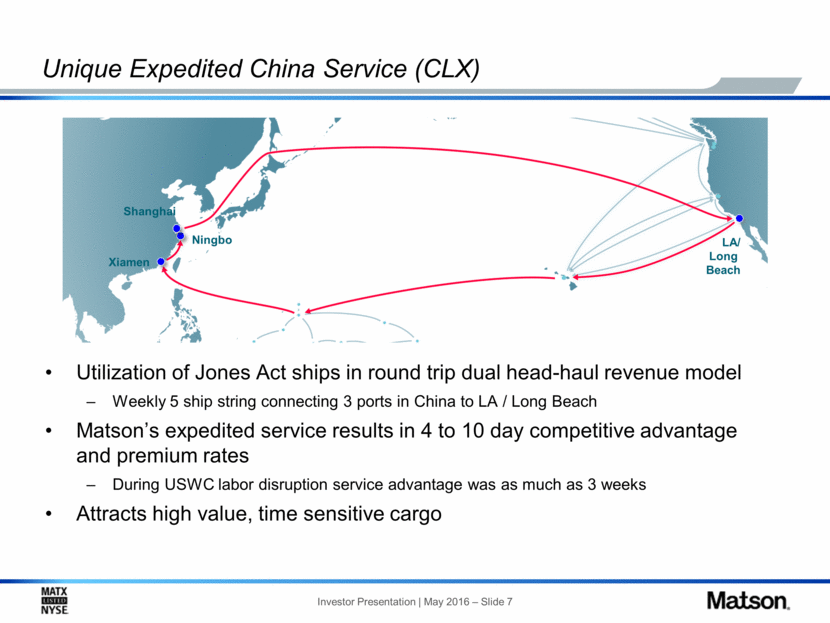
Matson’s China Service Differential from Shanghai International Service Matson CLX Service Matson Advantage Receiving: Customs Declaration and Terminal Cut-off Times 2 to 4 days 1 to 2 days 1 to 2 days Transit: Vessel Speed and Last Call vs Other Port Calls 12 to 15 days 10 days 2 to 5 days Discharge: Dedicated Terminals and Smaller Vessels to Unload 2 to 4 days 1 day 1 to 3 days Total Time 16 to 23 days 12 to 13 days 4 to 10 days Matson’s Premium Service Vessels Run at 21 knots Dedicated West Coast Terminals Efficient Terminal Operations Smaller Vessels to Load and Unload Late Receiving Times in China
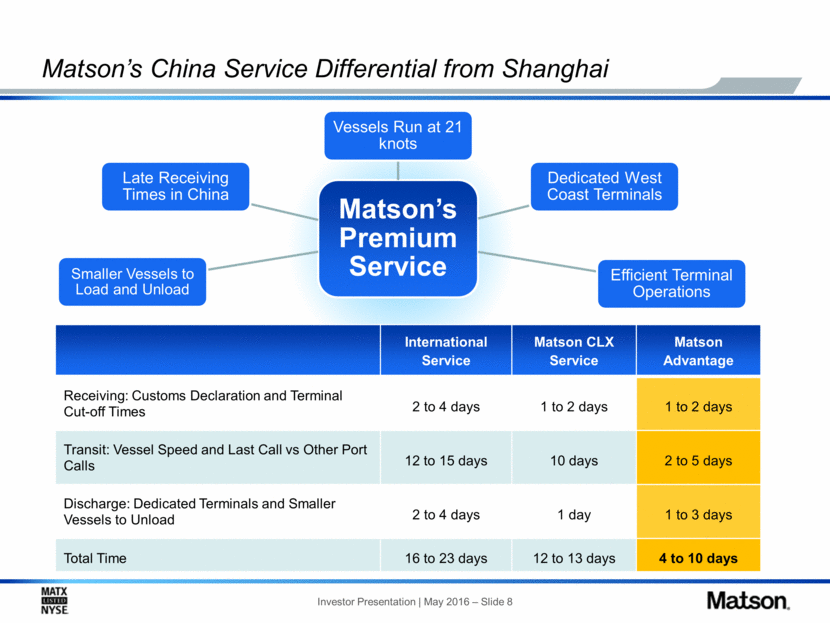
Guam a Critical Link in CLX Network Configuration Connections from Oakland and Pacific Northwest to Guam via Honolulu Volume in Guam remains stable; approximately 75% of Guam cargo is sourced from the U.S. On 8/29/15, the Department of the Navy signed the Record of Decision for relocating U.S. Marine Corps forces to Guam Approximately 5,000 Marines plus 1,300 dependents by 2022 Competitor launched a bi-weekly U.S. flagged service to Guam at beginning of 2016 Service approximately 9-10 days slower than Matson’s direct service Matson serves Micronesia through connecting carrier agreements with regional carriers Guam & Micronesia Service
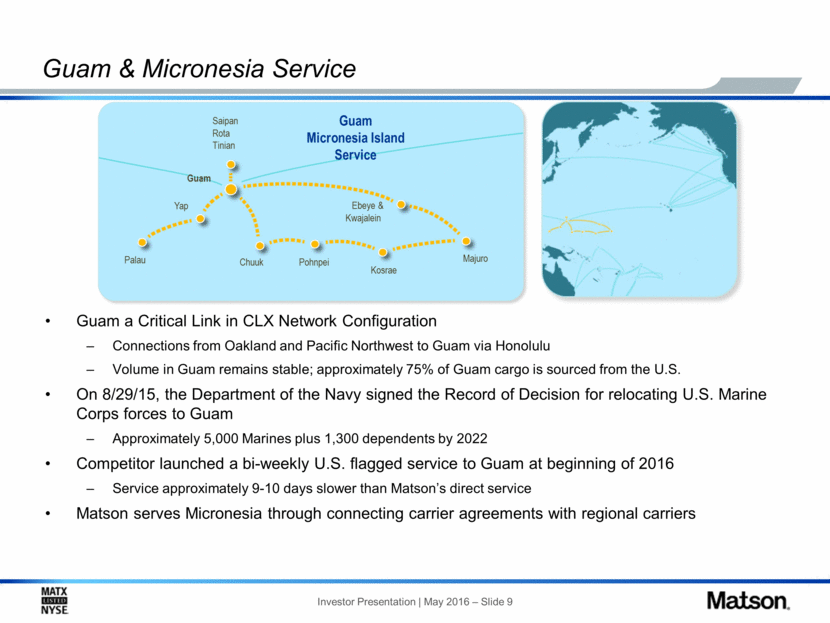
Alaska Service Similarities with Hawaii Market Remote, non-contiguous economy dependent on reliable container service as part of vital supply lifeline A market that values premium service Loyal customer base; ~80% overlap with Matson’s Hawaii customers Long-term Stable Revenue Profile Northbound volume represents ~75% of total Southbound volume more seasonal, driven by seafood industry Kodiak and Dutch Harbor operations are strategic Critical lifeline to these communities Important terminal and slot charter services for Maersk and APL 2X Weekly 1X Weekly 2X Weekly Matson’s 3-Ship Deployment Competitor’s 2-Ship Deployment

Matson’s 35% interest in leading U.S. West Coast terminal operator Contributed assets and terminal leases to JV in 1999 Terminals remain dedicated to Matson Services Vessel stevedoring, terminal services, container equipment maintenance, chassis pools, on-dock Rail Reduced Matson’s capital investment Terminal leases Cranes Controls cost and improves productivity Economies of scale Convert fixed cost to variable Maintains superior service Key to schedule integrity Exposure to Pacific Rim growth SSAT Joint Venture Terminals SSAT Market Share (1) Long Beach / LA 2 10% Oakland (2) 2 45% Seattle / Tacoma 2 20% (1) Approximate SSAT terminal lifts as a percentage of all terminal lifts by location in 2015 (2) Well positioned in Oakland for increased lift volumes due to closure of competitor’s terminal at end of March 2016
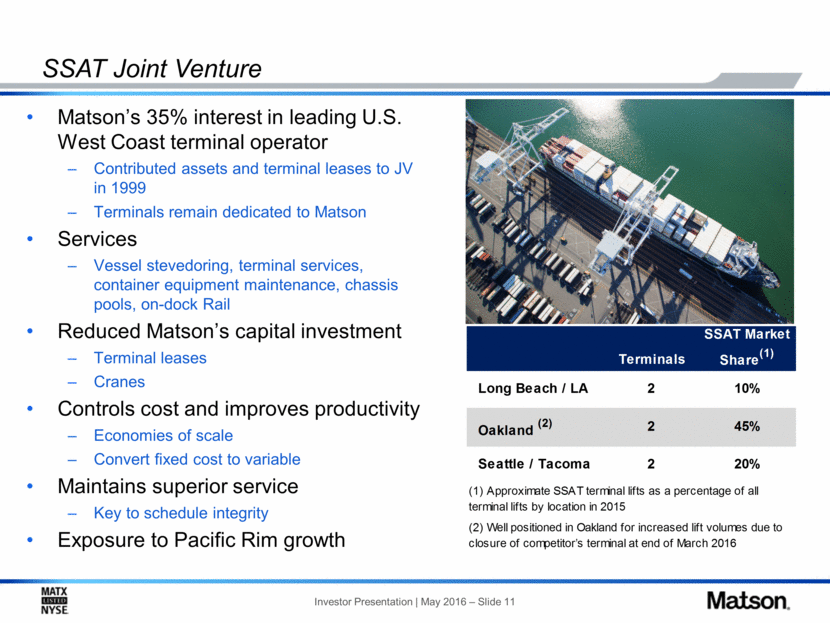
Matson Logistics A National Network of Integrated Services Leverages Matson brand Scalable model with high ROIC Improving results Warehouse operating improvements Returned operating margins to 2 - 4% target range Focus Organic growth as a national provider of integrated logistics solutions Pursue growth in freight forwarding and NVOCC services in China consolidation Consider disciplined acquisitions to expand service offering Domestic & International Intermodal Highway TL and LTL Warehousing & Distribution China Supply Chain Services
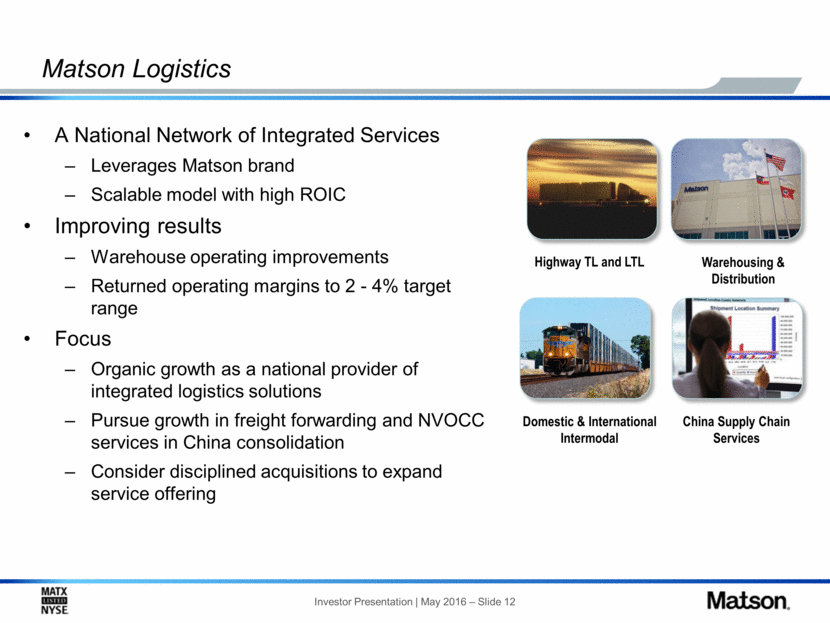
EBITDA, EPS – 1Q 2016 1Q16 Net Income of $18.1 million versus 1Q15 Net Income of $25.0 million See the Addendum for a reconciliation of GAAP to non-GAAP for Financial Metrics
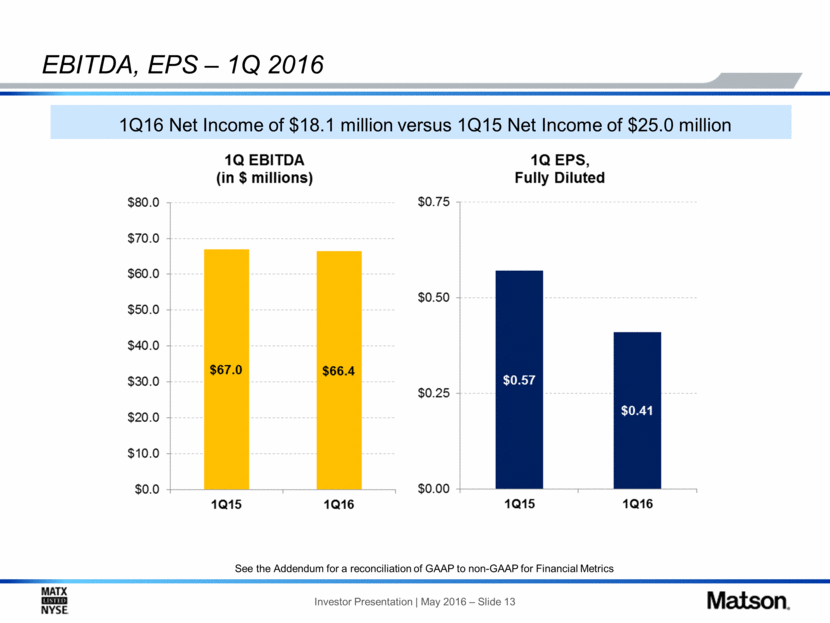
1Q2016 Operating Income SSAT had a $2.6 million contribution in 1Q16 compared to a $3.4 million contribution in 1Q15 1Q15 1Q16 Change Revenue $305.5 $366.1 $60.6 Operating Income $43.9 $33.0 ($10.9) Oper. Income Margin 14.4% 9.0% 1Q15 1Q16 Change Revenue $92.7 $88.1 ($4.6) Operating Income $1.0 $1.6 $0.6 Oper. Income Margin 1.1% 1.8% 1Q16 Consolidated Operating Income of $34.6 million versus $44.9 million in 1Q15
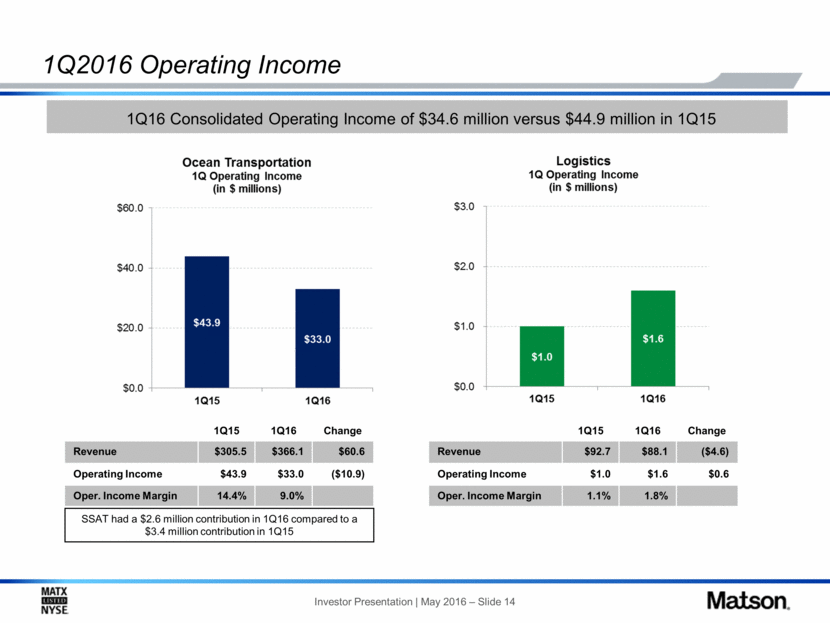
Consolidated Results EBITDA essentially flat year-over-year Operating income impacted by additional depreciation & amortization and vessel dry dock amortization Intangibles amortization from Alaska Acquisition Relatively heavy dry docking schedule Higher than normal maintenance capex Expect 2016 depreciation and amortization (incl. dry-docking amortization) of approximately $133 million, compared to $105.8 million in 2015 Consolidated Results ($ in millions) 1Q16 1Q15 Net Income $18.1 $25.0 Add: Income tax expense $11.6 $15.6 Add: Interest expense $4.9 $4.3 Operating Income $34.6 $44.9 Add: Depreciation & Amortization $23.7 $16.6 Add: Drydock Amortization $8.1 $5.5 EBITDA $66.4 $67.0
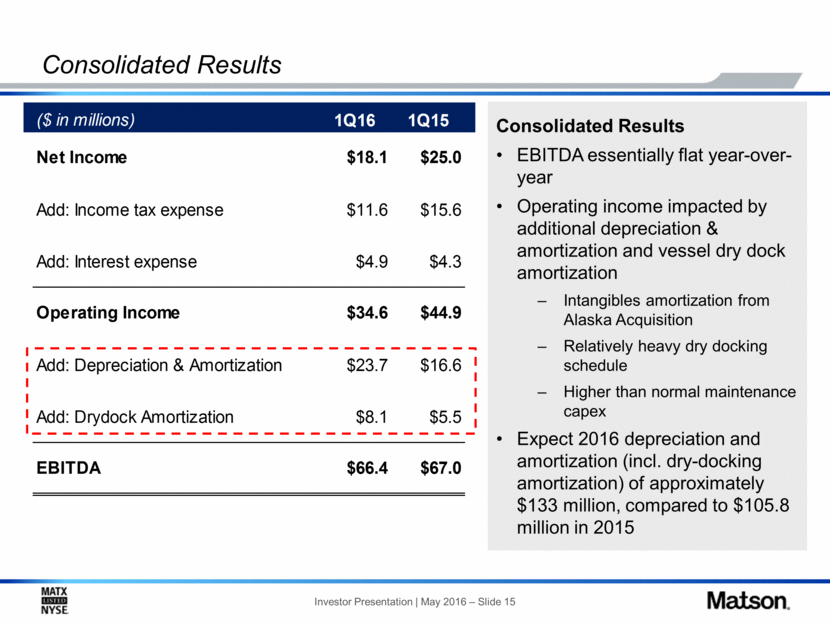
Condensed Balance Sheet Assets (in $ millions) 3/31/16 12/31/15 Cash and cash equivalents $ 20.1 $ 25.5 Other current assets 238.8 252.4 Total current assets 258.9 277.9 Investment in terminal joint venture 69.0 66.4 Property and equipment, net 857.4 860.3 Capital Construction Fund – cash on deposit 12.5 - Intangible assets, net 137.2 139.1 Goodwill 241.6 241.6 Other long-term assets 97.7 84.5 Total assets $1,674.3 $1,669.8 Liabilities & Shareholders’ Equity (in $ millions) 3/31/16 12/31/15 Current portion of debt $ 21.7 $ 22.0 Other current liabilities 239.5 275.6 Total current liabilities 261.2 297.6 Long-term debt 459.5 407.9 Deferred income taxes 313.3 310.5 Other long-term liabilities 200.6 203.2 Total long term liabilities 973.4 921.6 Shareholders’ equity 439.7 450.6 Total liabilities and shareholders’ equity $1,674.3 $1,669.8 Liquidity and Debt Levels Total debt of $481.2 million, Net debt of $448.6 million Net debt to LTM EBITDA of 1.5x During 1Q16, Matson repurchased 518,600 shares at an average price of $38.81 per share See the Addendum for a reconciliation of GAAP to non-GAAP for Financial Metrics
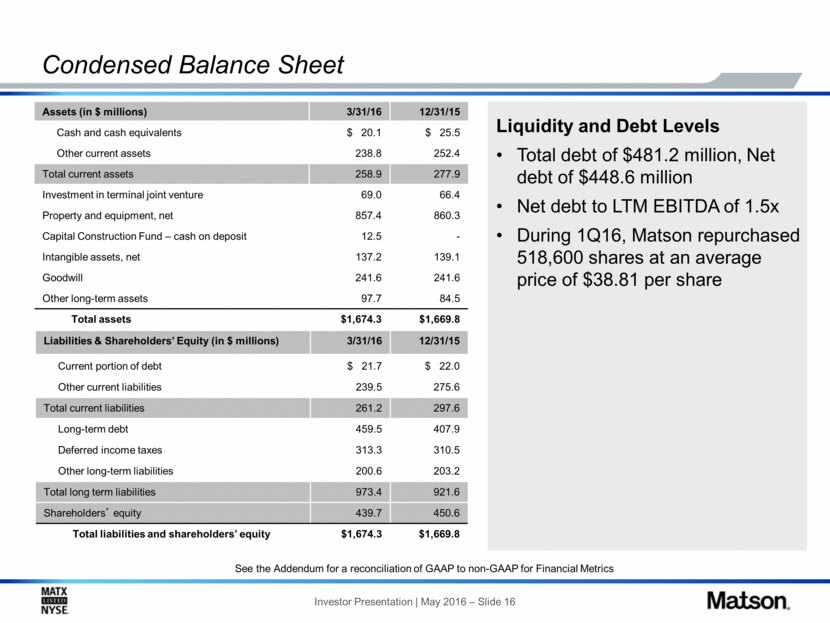
Cash Generation and Uses of Cash Includes $15 million net CCF withdrawal; does not include $0.6 million in other sources of cash Based on total cash consideration (including common shares, warrants, repaid debt, accrued interest and breakage fees)
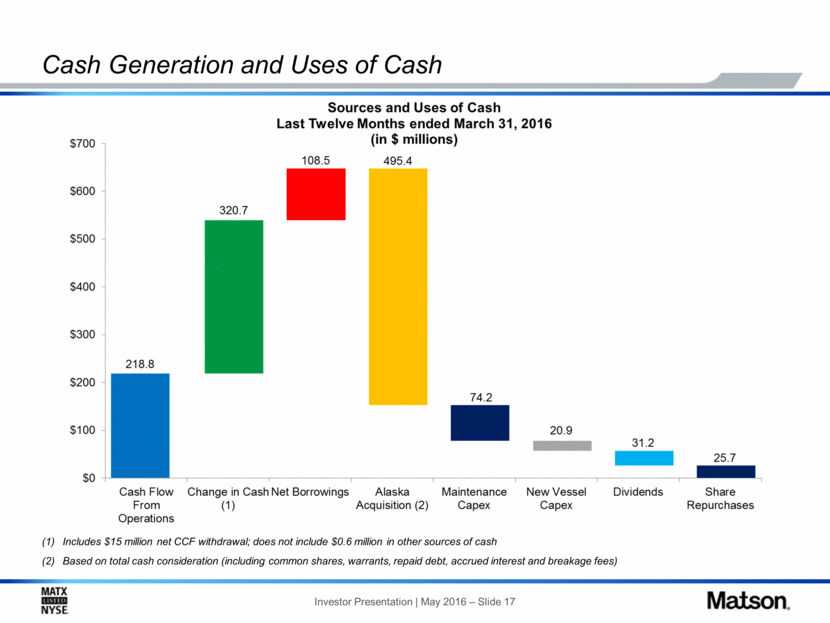
2016 maintenance capital spending expected to be approximately $65 million Higher than normal expected range of $40-50 million due to installation of scrubbers on Alaska vessels, and capital projects related to a relatively heavy dry docking schedule New vessel progress payments for two Aloha Class vessels under construction at Philly Shipyard 2016 $67.2 million, 2017 $159.1 million, 2018 $154.1 million, 2019 $8.4 million Capital Expenditures
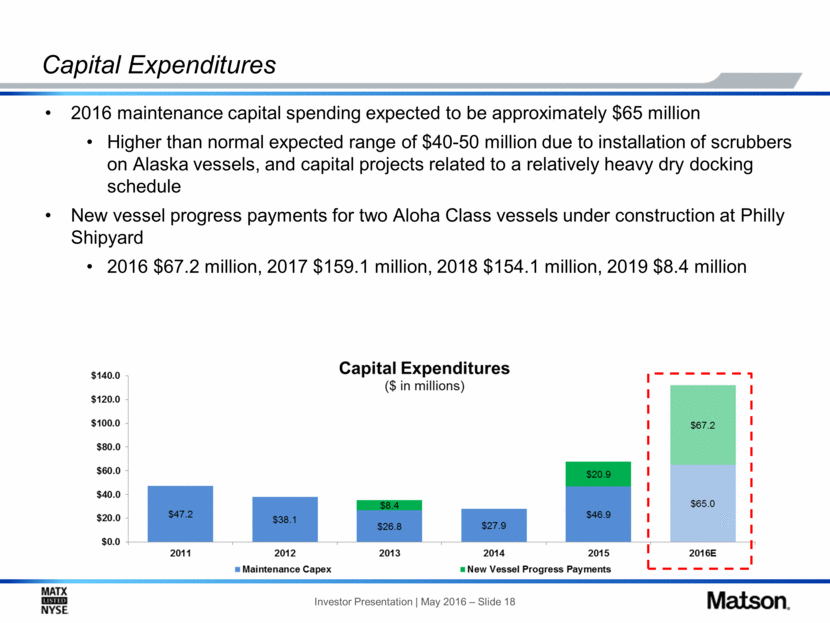
Expect 2016 vessel dry-docking expenditures of approximately $60 million Hawaii fleet – Vessels dry-dock once every 5 years 2011 and 2012 has heavy dry-docking expenditures; therefore, expect 2016 and 2017 to have relatively heavy dry-docking expenditures Alaska fleet – Vessels dry-dock twice every five years Matson decided to dry-dock two of the inactive vessels acquired from Horizon Lines such that they are in-class and available for deployment Expect 2016 depreciation and amortization (incl. dry-docking amortization) of approximately $133 million, compared to $105.8 million in 2015 Expect 2016 vessel dry-docking amortization of approximately $35 million, compared to $23.1 million in 2015 Vessel Dry-Docking

Outlook is being provided relative to 2015 operating income Ocean Transportation operating income for full year 2016 is expected to be approximately 15 to 20 percent lower than the $187.8 million achieved in 2015, and for 2Q16 is expected to approximate the $31.4 million achieved in 2Q15 Significantly lower average freight rates in China Higher depreciation and amortization expense due to increased capital and vessel dry-dock spending Modest competitive volume losses in Guam Modestly lower contribution from SSAT joint venture Moderately higher Hawaii container volume Full year contribution from Alaska operations Absence of acquisition related incremental SG&A and Molasses Settlement costs Logistics operating income for full year 2016 expected to modestly exceed 2015 level of $8.5 million Interest expense for full year 2016 expected to be approximately $19.0 million Effective tax rate for full year 2016 expected to be approximately 39.0 percent 2016 Outlook

Addendum
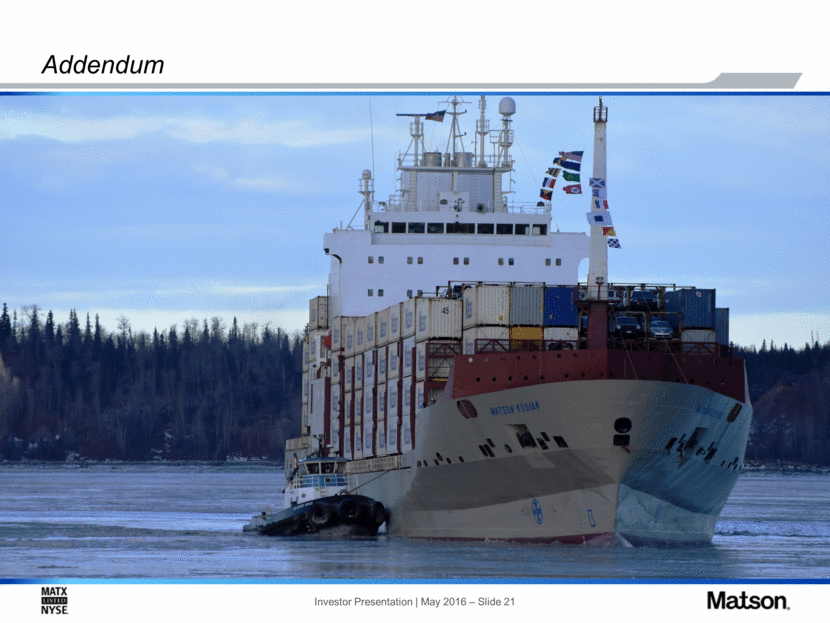
Addendum – Non-GAAP Measures Matson reports financial results in accordance with U.S. generally accepted accounting principles (“GAAP”). The Company also considers other non-GAAP measures to evaluate performance, make day-to-day operating decisions, help investors understand our ability to incur and service debt and to make capital expenditures, and to understand period-over-period operating results separate and apart from items that may, or could, have a disproportional positive or negative impact on results in any particular period. These non-GAAP measures include, but are not limited to, Earnings Before Interest, Depreciation and Amortization (“EBITDA”), and Net Debt/EBITDA. NET DEBT RECONCILIATION $ 481.2 Less: Cash and cash equivalents (20.1) Capital Construction Fund - cash on deposit (12.5) $ 448.6 EBITDA RECONCILIATION Change $ 18.1 $ 25.0 $ (6.9) $ 96.1 Add: Income tax expense 11.6 15.6 (4.0) 70.8 Add: Interest expense 4.9 4.3 0.6 19.1 Add: Depreciation and amortization 23.7 16.6 7.1 89.8 Add: Dry-dock amortization 8.1 5.5 2.6 25.7 $ 66.4 $ 67.0 $ (0.6) $ 301.5 (In millions) EBITDA (1) 2016 2015 Net Income Months Last Twelve March 31, Total Debt: March 31, 2016 (In millions) Net Debt Three Months Ended
